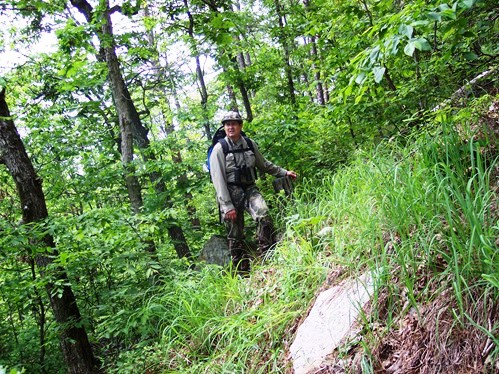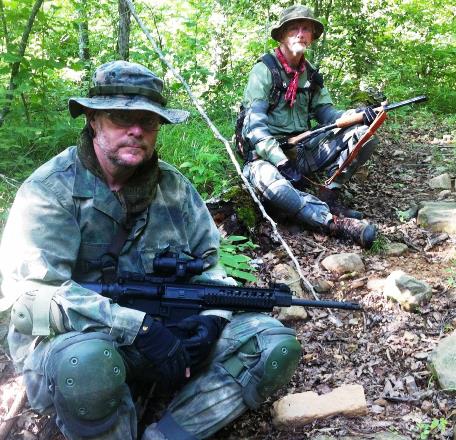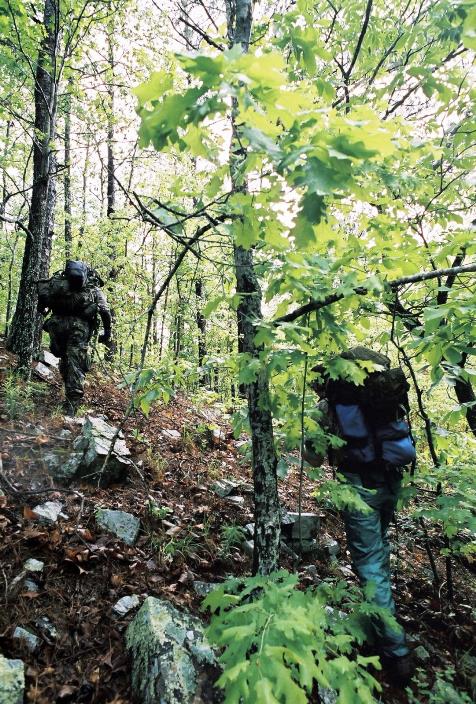In a remote valley in the US researchers hunt for a phantom: Bigfoot. Is the mysterious ape creature merely legend, or is it reality? Researchers are looking for it – equipped with guns.
“It’s like a jungle here,” said biologist Alton Higgins. “Large areas are completely undeveloped. The vegetation is dense and the biodiversity is great.” The photos he shows back up his words. Green hills as far as the eye can see, a wild brook that winds through dense brush. The landscape is more reminiscent of Central Africa than the United States, but it is in the Ouachita Mountains, in the heart of North America.

Here, in this wild region in Oklahoma, a group of American researchers search for a phantom. An unknown ape, so they claim, lives in these forests. An animal, like the gorilla or chimpanzee, that walks on two legs like a man, is agile, extremely fast, and shy.
“We have now seen them dozens of times,” says Higgins. “Different animals. Juveniles and older. One we call Old Gray. The animal is about two meters tall, heavily muscled and covered with silver-gray hair.” Higgins himself saw Old Gray when the animal flitted across a clearing. Another researcher observed it crossing a river – in spite of its size and stature it was completely silent and graceful on the stones as it entered the undergrowth.
The reports of Alton Higgins and the North American Wood Ape Conservancy (NAWAC) sound fantastic. So fantastic that they could have come from the pen of the writer Arthur Conan Doyle. Much like the characters in “The Lost World,” NAWAC researchers maintain they have encountered a kind of forgotten world supporting primeval creatures. “I would probably not believe it if someone else were to tell me,” says Daryl Colyer. “However, I can only stress that our reports are true and these animals undoubtedly exist.”
18 Unique Sightings
Colyer is ex-military intelligence, has a degree in history, is from Texas, and works in the private sector today. “The recent expedition in the summer of 2014 lasted four months and around 40 people participated,” he says. Researchers entered the remote valley in small groups and spent days or weeks. “In 122 days total, there were 18 unique sightings.” Alton Higgins alone saw the creatures four times.
Colyer and the teams documented events that the researchers thought were connected with the mysterious apes. For instance, stones were thrown into the camp of the researchers – the cabin roof, in particular, is a popular target – or limbs were torn and smaller trees were knocked down.
The experiences of Higgins and Colyer are indeed impressive, but not unique. In various places in America great ape-like creatures have been reported again and again, especially in the heavily wooded areas in the northwest. The creatures are known as Bigfoot – because of the huge footprints they leave. Some call them Sasquatch – a name derived from the language of indigenous people to mean Wildman of the Woods. Higgins and his colleagues call them “wood apes.” They want to distance themselves from the term “Bigfoot” – it carries too many negative connotations. It is associated too much with tabloids, hoaxes, and crackpots, says Colyer.
In 2008, a man from Georgia claimed to have killed a Bigfoot. His story dominated press headlines for weeks. In the end, the whole thing turned out to be false.
Officially, Bigfoot does not exist. Most scientists laugh about the claims of Bigfoot researchers. Primatologist Thomas Geissmann of the University of Zurich says such reports are merely entertainment and have no scientific value. “I do not think for a moment that Bigfoot exists,” says the primate researcher who specializes in gibbons. Furthermore, apes live in tropical jungles. “Although I have not read the reports of NAWAC, I know the claims of Bigfoot researchers sufficiently. They never convinced me.”
A Dead Animal as Evidence
Due to the number of scientists involved, the reports of the NAWAC are more credible than others. However, all the NAWAC can present is claims. They have no evidence, a fact criticized by Geissmann: “It would be easy to get a good photo of these animals,” he said. “The researchers would only need a few photo-traps set up in the region, then they should eventually get a clear shot.”
In fact, the NAWAC attempted this. “It was a flop,” says Colyer. “We obtained hundreds of photographs of black bears, but none of a wood ape.”
Gathering photographic evidence is no longer the primary goal of the NAWAC, he explains. Would pictures be enough for either science or the government? Only a dead specimen can provide clear evidence of their existence. Therefore NAWAC researchers no longer chase through the forest with cameras, but with large caliber weapons.
Colyer came very close to providing the ultimate proof in 2011. He fired his shotgun at an upright large animal moving smoothly through the undergrowth. “We found blood spatter on stones, but no body.” It is incredibly difficult to hunt these animals, the experienced hunter explains. “These animals are like ninjas: extremely fast and silent.” Colyer’s NAWAC colleague Travis Lawrence, a high-school math teacher from Spring, Texas, came even closer in the summer of 2013.

On that night Lawrence was positioned in a tent – with a gun that had a thermal imaging scope. The thermal imaging technology, which is used by rescue workers in the search for missing persons, makes it possible to see creatures in absolute darkness.
Alton Higgins was located near Lawrence in another tent. It served as a kind of bait to attract the interest of wood apes. At about 4 o’clock he awakened. Then he slid the zipper on the tent door to create noise to attract the interest of any lurking primates. Lawrence recalls what happened next: “Suddenly I saw a shining figure [illuminated and visible in the thermal scope] near Alton’s tent. I only saw the upper body, the lower part was hidden by bushes. The figure was tall, had a pointed head and powerful trapezius muscles. For me it was clear what I saw.” Within seconds Lawrence directed the crosshairs on the creature’s head and pulled the trigger. “I thought it was done.”
But disappointment came quickly. Despite an intensive search, they found no corpse. What they did find, where Lawrence had seen the creature, were several branches with damage. “The projectile was deflected significantly,” says Lawrence. He would have made the world a fascinating puzzle poorer, but science a sensational discovery richer.
The Hunt for DNA
The wood ape would have been one of about 30 species of mammals discovered in 2013. Even today, in a world in which humans have penetrated into the most remote reaches of the earth, and Google and Wikipedia give us a sense of omniscience and omnipresence, new creatures are discovered.
UZH primatologist Thomas Geissmann criticized the actions of the NAWAC. “I am sure that it is not necessary to kill a specimen. I have described several new species of monkeys and never had to kill an animal for it. “
In 2005 Geissmann and colleague Urs Thalmann described a new lemur species. Hair as well as photo and video material and audio recordings were enough. “It takes just a few hairs of a Bigfoot to unambiguously tell if it exists and what it is.”
Alton Higgins understands Geissmanns’s reasoning. “We have been trying for years to collect DNA.” After Colyer fired at an ape, traces of blood were found, however, not until several days later. “The blood was dried up, and the analysis brought no DNA to light,” said Higgins.
“They Resembled Chimpanzees”
DNA evidence would have to exist in large quantities. “But our experience has shown that it is very difficult to get that. The analyses are also very expensive. We are therefore convinced that it is most efficient to collect one. It is morally justifiable, especially because it represents the first step towards the protection of the animals.”

“We don’t know how many wood apes live in the region, or in North America, or whether they are even at risk,” Higgins says. “The fact that we observe animals of various sizes and hair color in this place suggests a larger group.” In particular, a sighting last summer was significant: four juveniles climbed down from a tree and fled. “They resembled chimpanzees and ran on all fours,” eyewitness Travis Lawrence recalls. From this sighting it can be concluded that there were several mothers in the valley. Higgins regards the place as a refuge, a haven where the animals can feed, rest, and reproduce. “We don’t know yet how many such refuges exist in North America. This may be one of the last.”
Click here for the source article.
